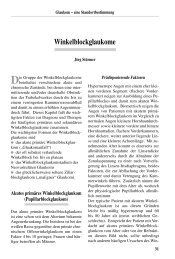Neven Olivari • Endokrine Orbitopathie - Dr. R. Kaden Verlag
Neven Olivari • Endokrine Orbitopathie - Dr. R. Kaden Verlag
Neven Olivari • Endokrine Orbitopathie - Dr. R. Kaden Verlag
Sie wollen auch ein ePaper? Erhöhen Sie die Reichweite Ihrer Titel.
YUMPU macht aus Druck-PDFs automatisch weboptimierte ePaper, die Google liebt.
VIII<br />
Geleitwort<br />
Endocrine ophthalmopathy, or Graves disease, is a<br />
condition which, over the years, has repeatedly taxed<br />
the ingenuity of ophthalmic surgeons and a small<br />
group of plastic surgeons interested in this condition.<br />
Initially the operations were technically relatively<br />
minor but with the advent of craniofacial surgery more<br />
major procedures were developed and performed.<br />
Unfortunately, these led to only a minimal improvement<br />
in results and sometimes the complications, such<br />
as diplopia, were significant and frequent. The real<br />
problem in terms of treatment was the lack of an adequate<br />
analysis of the problem. This has now been<br />
greatly helped by more sophisticated imaging techniques<br />
such as MRI scanning together with the aid of<br />
three-dimensional CT scanning techniques. It has<br />
now become obvious that it is the increase in conal fat<br />
which seems to be the most significant factor in the<br />
causation of this distressing deformity.<br />
The method described by <strong>Neven</strong> <strong>Olivari</strong>, and so<br />
beautifully presented in this book, is logical.<br />
Unfortunately, when it is presented or demonstrated<br />
by <strong>Neven</strong> <strong>Olivari</strong>, it seems simple to execute. However,<br />
at that point we are watching or listening to a master<br />
surgeon with a huge amount of experience in all<br />
aspects of plastic surgery but particularly in the orbit,<br />
demonstrating a technique which he has pioneered and<br />
developed over many years. To many, the method and<br />
its execution has been something of a mystery. All has<br />
now been revealed in this very clear and well produced<br />
treatise. This is undoubtedly a giant step forward<br />
in the treatment of this condition which affects<br />
so many of our patients. The book must, however, be<br />
read extremely carefully and even after having done<br />
this I would advise for those who are inexperienced to<br />
practice on a cadaver, if possible, using the textbook<br />
like a dissection manual. Those who are experienced in<br />
orbital surgery, of course, will not require this but they<br />
must follow the step-by-step instructions provided by<br />
the author. In this way good results will be obtained<br />
and complications avoided.<br />
We must sincerely thank <strong>Neven</strong> <strong>Olivari</strong> for producing<br />
this publication. He has done a great service to<br />
orbital surgery and to the unfortunate patients who<br />
suffer from the problem of endocrine ophthalmopathy.<br />
I am sure that this will be instrumental in many<br />
patients retaining their sight who otherwise would not<br />
have done so. This may be the greatest complement<br />
that can be applied to this account of his lifelong study<br />
of this distressing problem.<br />
Ian T. Jackson<br />
MD, DSc (Hon), FRCS, FACS, FRACS (Hon)<br />
Institute for Craniofacial and Reconstructive Surgery<br />
Southfield, Michigan, USA



